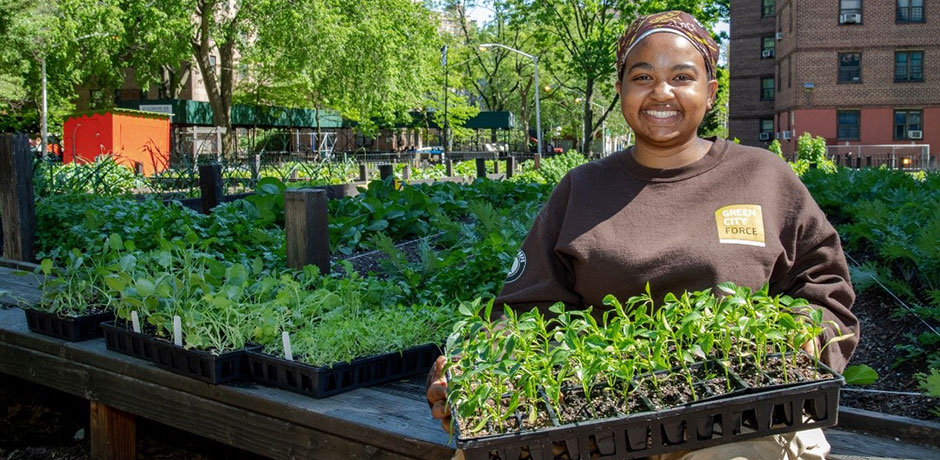City Blooming Fundamentals Explained
Wiki Article
Some Known Questions About City Blooming.
Table of ContentsNot known Details About City Blooming The 6-Second Trick For City BloomingCity Blooming for DummiesSome Ideas on City Blooming You Need To KnowFascination About City Blooming
Interested in expanding food for sale in the City of Chicago? Below is a list of regularly asked questions concerning the regulations and guidelines that farmers must consider when intending an urban farming project.
The zoning modification does not modify any kind of other codes managing composting, building authorizations, purchasing or renting City owned property, organization licenses or ecological contamination. There are existing codes that manage these problems and they remain completely result and may apply to your task. Area yards are generally possessed or taken care of by public entities, civic organizations or community-based companies and maintained by volunteers.
Urban ranches grow food that is planned to be offered, either on a not-for-profit or for-profit basis. Because of their industrial objective, city farms need a company certificate. Yes. A neighborhood yard is allowed to offer surplus produce that was grown on site if the sales are accessory or subservient to the yard's primary objective described above.
An Unbiased View of City Blooming
Composting is enabled however only for plant material that is produced and made use of on website. The amount of garden compost product can not surpass 25 cubic backyards at any given time according to the standards in 7-28-715 of the City's Municipal Code. Yes. Due to the fact that the dirt at a lot of new garden sites requires modifying, garden compost, dirt, wood chips, or other products can be acquired to construct or improve the expanding space - fruit and vegtables.
If a building permit is required after that the hoophouse will be considered an accessory building. You can learn even more regarding the building authorization requirements by speaking to the Division of Structures. The 25,000-square-foot size limit is intended to avoid a single neighborhood garden from controling an offered block or interfering with the block's existing domestic or commercial personality.
The restriction does not apply to yards located in Public Open Area (POS) districts. Can there be even more than one area garden that is 25,000 square feet on a solitary block? Secure fencing is not needed, however, yards that have large vehicle parking locations might be required to set up secure fencing or various other landscaping attributes.
Our City Blooming Statements
B1 & B2 areas require that all industrial usage activities be performed indoors. Is secure fencing needed for metropolitan ranches? Fencings may be called for, along with landscape design and testing, for certain auto parking locations and exterior job or storage locations depending on location and the particular activity taking place.Urban ranches call for building licenses and zoning approvals prior to construction (City gardening). Various other types of city evaluation may be required depending on details structures, tasks, dimension, landscape design, licensing, public health and stormwater monitoring issues.
The Division of Company Affairs and Customer Defense can assist determine the particular kind of company permit that's required. Off street car park is needed for many commercial tasks in Chicago. The called for number of auto parking areas is based on the number of workers functioning on site and not the square footage of the growing room.
What Does City Blooming Mean?

A metropolitan ranch can offer garden compost material generated on website, nevertheless, the procedure must abide with the laws in 7-28-715 of the Chicago Municipal Code. Aquaponic systems are allowed inside on urban ranches in numerous zoning areas.
As much as 5 hives or colonies of honey might be maintained as an accessory usage. Beekeepers should sign up with the Illinois Department of Farming. For more details regarding the recommended zoning change you may get in touch hop over to these guys with the Department of Housing and Economic Growth, Bureau of Preparation and Zoning at 312.744.8563.
Farming in cities and city locations A metropolitan farm in Chicago. Urban farming refers to various practices of growing. https://www.behance.net/danielnold, processing, and dispersing food in city areas. The term also uses to the area activities of animal husbandry, aquaculture, beekeeping, and horticulture in a city context. Urban agriculture is distinguished from peri-urban agriculture, which happens in country areas beside residential areas.
More About City Blooming
, that look for to develop social networks established on a common ethos of nature and area holism. These networks can develop by means of formal institutional support, ending up being incorporated right into regional town preparation as a "transition town" motion for sustainable city advancement.In either case, the more straight accessibility to fresh vegetable, fruit, and meat items that may be understood through metropolitan farming can boost food protection and food security while reducing food miles, causing lower greenhouse gas emissions, consequently contributing to climate modification mitigation. Some of the very first proof of city farming originates from Mesopotamia.
Report this wiki page